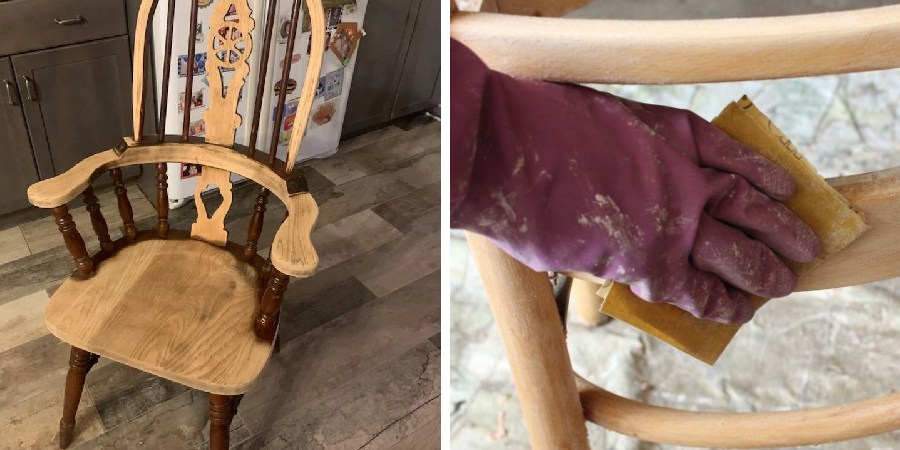Are your chair spindles looking a bit worn and in need of comfort? If so, don’t worry – reworking them is easier than you think! Sanding chair spindles can be a simple and straightforward way to give the furniture an updated look without sacrificing its classic charm. In this blog post, we will take you through the process of how to sand chair spindles step-by-step so that even those who have never tried sanding before can finish the job with ease. With some patience and the right tools on hand, your beloved chairs will soon be revitalized and ready for use once again!

What Grit Sandpaper for Spindles?
When sanding spindles, start with medium-grit sandpaper (60 to 80 grit) and gradually move toward fine grit (100 to 120). This will help you get an even finish on the wood. Start by running the sandpaper along each spindle in one direction until all sides are evenly smoothed out.
You can also use a palm sander and sandpaper discs, but be sure to keep the sander moving so you don’t create burn marks. After you have finished sanding in one direction, move the paper or sander in the opposite direction. This will help remove any scratches left by your first pass. Finally, finish up with very fine grit sandpaper (200-grit) to get a smooth, polished finish.
Once you have finished sanding the spindles, wipe them clean with a damp cloth to remove any dust or debris. This will help ensure that you get an even stain or paint on the furniture piece. If necessary, use a wood filler to fill in any holes or cracks before you apply the finishing coat. With a bit of time and effort, you can make old furniture look like new again!
Why Sand Chair Spindles?
There are a few reasons why you might need to sand chair spindles. Over time, wooden furniture can become dull and lose its shine due to exposure to sunlight, dust and dirt. Sanding these areas can help remove the top layer of damaged wood and reveal the fresh, untouched wood underneath. \Additionally, if your chairs have been painted or stained, sanding can help remove old layers of paint or stain and give you a clean surface to work with. Sanding chair spindles is also helpful in removing any scratches, dings, or imperfections that may have developed over time. This will give your furniture a smoother and more consistent look.

Needed Tools and Materials
Before you start sanding your chair spindles, make sure you have all the necessary tools and materials. This will save you time and hassle later on. Here is a list of what you will need:
Medium to Fine Grit Sandpaper (60, 80, and 100-120-grit):
Depending on the level of damage and type of wood, you may need sandpaper in different grits to achieve a smooth finish. Start with medium grit and gradually move towards finer grit for best results.
Sanding Block or Palm Sander:
Using a sanding block or palm sander can help you achieve an even and consistent finish on the spindles.
Wood Filler:
If there are any holes, cracks, or imperfections in the wood, use a wood filler to fill them in before sanding.
Damp Cloth:
Wipe down the spindles with a damp cloth to remove any dust or debris before staining or painting.
Stain or Paint:
Choose a stain or paint of your choice to give your chair spindles a brand-new look.
9 Methods How to Sand Chair Spindles
1. Use a Rotary Tool
One of the easiest ways to sand chair spindles is to use a rotary tool. Rotary tools are small, handheld power tools that come with a variety of attachments. The most common attachment for sanding is a sanding pad. Simply attach the sanding pad to the rotary tool and turn it on. Begin sanding the spindles with the rotary tool using light pressure. If the spindles are extremely rough, use a higher grit sandpaper.
2. Use an Electric Sander
Another option for sanding chair spindles is to use an electric sander. Electric sanders are larger and more powerful than rotary tools, making them ideal for tougher sanding jobs. However, they can be more difficult to maneuver, so be sure to keep your spindle in a stable position while using an electric sander. Choose the right sandpaper grit for the job and follow the same sanding technique as with the rotary tool. First, test the electric sander in an inconspicuous area of the chair to make sure it won’t damage the wood. Once finished, use a cloth to wipe away any dust and debris from the spindles.
3. Use a Handheld Sander
If you don’t have access to an electric sander, you can use a handheld sander instead. Handheld sanders are smaller and less powerful than electric sanders, but they can still get the job done. Start by attaching a piece of sandpaper to the sander and turning it on, then move it over the chair spindle in a circular motion. You want to sand in the same direction that the grain is going. Move your hand slowly over the spindle, making sure to cover all areas evenly. After you have finished sanding, inspect the spindle to make sure it is completely smooth. If there are any remaining bumps or ridges, repeat the sanding process until they are gone. Once you are satisfied with the finish, it is time to move on to the next step.
4. Use Sandpaper
If you don’t have any power tools, you can still sand your chair spindles using sandpaper. Start with coarse-grit sandpaper and work your way up to fine-grit sandpaper as you progress. To get into the crevices, you may need to use sanding sticks. Work in a circular motion, and make sure to sand the whole spindle evenly. Once you’re done sanding, use a vacuum to remove any sawdust that may be left behind. This is important for a smooth finish. Once you’ve removed all the sawdust, take a damp cloth and wipe down the spindle to eliminate any remaining dust.

5. Use Steel Wool
Another option for those without power tools is to use steel wool. Steel wool is a very fine abrasive material that can be used for sanding wood. To use it, simply rub the steel wool over the surface of the wood in a circular motion until you’ve achieved the desired level of smoothness. Be sure to wear gloves when using steel wool, as it can be harsh on the skin. Additionally, keep in mind that steel wool will leave small bits of steel on the wood, so be sure to clean it up after use. It is also important to note that steel wool may not be the best option for sanding chair spindles, as a power sander will be able to provide a much smoother finish.
6. Use a Drum Sander
If you have access to a drum sander, you can use it to sand your chair spindles. A drum sander is an electric tool that consists of an abrasive belt wrapped around a cylindrical drum. To use one, simply turn the machine on and move it back and forth over the spindles to sand them. Be sure to use a light touch and check your spindles often for smoothness. Adjust the speed or pressure on the belt as needed. It’s a good idea to practice scrap wood before you sand your spindles to get familiar with the machine. When you’re done, use a vacuum or brush to remove the sawdust.
7. Use a Belt Sander

A belt sander is another type of electric tool that can be used for sanding chair spindles. This type of sander consists of an abrasive belt that moves in a continuous loop around two drums. To use it, simply turn the machine on and move it back and forth over the spindles to sand them. Be sure to use light pressure and move the sander slowly over the wood so that you don’t damage it. You can also adjust the machine to change the speed of the belt for a more customized sanding experience. Once all sides have been sanded, switch out the belt for a finer grit in order to really smooth out the surface.
8. Use a Spindle Sander
A spindle sander is an electric tool similar to a belt sander, but instead of an abrasive belt, it has a cylindrical drum with sandpaper wrapped around it. To use it, simply turn the machine on and move it back and forth over the spindles to sand them. Make sure to keep the sanding motion consistent, even so that you don’t have any dips or grooves in the spindles. You can also use a spindle sander to round off any sharp edges if needed. Be sure to wear safety goggles while sanding with the spindle sander to protect your eyes from flying wood chips. When you’re finished sanding, use a soft cloth to wipe down the spindles and remove all of the dust. Your chair spindles should now be smooth and ready to be painted or stained.
9. Use a Finishing Sander
If you just need to do some light sanding, a finishing sander can be a great option. These small tools offer very precise maneuverability, allowing you to get into tight corners and edges. Finishing sanders come with a variety of interchangeable sanding discs, so you can use the one that is best suited for your particular project. When sanding chair spindles, start with coarse grit and work your way up to a finer one. Make sure to go in the same direction as the grain of the wood to avoid scratching or gouging. After sanding, wipe off any dust with a damp cloth and apply primer before painting. With a finishing sander, you can get great results in less time than hand sanding.
By following these steps on how to sand chair spindles, you can get great results when sanding chair spindles. Sanding is an important part of woodworking and a key step in creating beautiful, durable furniture. No matter which method you choose to use when sanding your spindles, always be sure to wear eye and ear protection for safety. Happy sanding!
Do You Need to Get Help From a Professional?
While sanding chair spindles can be done by anyone with the right tools and techniques, some people may prefer to seek help from a professional. This is especially true for those who are not comfortable using power tools or have limited experience with woodworking. Additionally, if you have a large number of chairs to sand, it may be more efficient and cost-effective to hire a professional who can complete the task quickly and efficiently.
Ultimately, the decision to seek professional help will depend on your skill level, time constraints, and budget. Just remember, no matter which option you choose, a smooth finish is key for comfortable and visually appealing chairs!
So, if you’re not confident in your sanding abilities or don’t have access to the necessary tools, don’t hesitate to reach out to a professional for assistance. They will ensure that your chair spindles are sanded properly and ready for whatever finish you have in mind. With their expertise, you can rest easy knowing that your chairs will be looking their best. In the end, the most important thing is that you are able to enjoy your beautifully sanded and finished chairs for years to come.

Frequently Asked Questions:
Q: Can I Use Steel Wool to Sand My Chair Spindles?
A: Yes, steel wool can be used as an abrasive material for sanding wood. However, keep in mind that it may not provide the smoothest finish and will leave small bits of steel on the wood. It is important to clean up these bits after use. You may also want to consider using a power sander for a smoother finish.
Q: Can I Paint My Chair Spindles After Sanding?
A: Yes, once you have sanded your chair spindles, you can paint or stain them as desired. Just make sure to wipe off any sawdust and apply a primer before painting for the best results. The sanded surface will also help the paint or stain adhere better for a longer-lasting finish. So, sanding your chair spindles is an essential step in preparing them for painting or staining.
Q: How Long Does it Take to Sand Chair Spindles?
A: The time it takes to sand chair spindles can vary depending on the method used and the condition of the spindles. Hand sanding may take longer than using a power sander or drum sander. Additionally, if the spindles are in rough shape, it may take more time and effort to achieve a smooth finish. It is best to set aside ample time and work at a steady pace for the best results.
Q: Can I Sand Chair Spindles Without Power Tools?
A: Yes, you can sand chair spindles without power tools by using sandpaper and steel wool. However, it may take more time and effort than using a power sander. It is important to make sure that the sanding motion is consistent and even to avoid any dips or grooves in the wood. Using a finishing sander can also be a good option for light sanding without power tools. Overall, using power tools can make the sanding process more efficient and effective, but it is possible to achieve good results without them.
Q: How Often Should I Sand My Chair Spindles?
A: The frequency of sanding your chair spindles will depend on their condition and how much they are used. If they start to feel rough or have visible scratches, it may be time for a light sanding. It is also a good idea to sand before painting or staining for the best results. Regular maintenance and care can help keep your chair spindles in good condition, reducing the need for frequent sanding. So, make sure to check and sand your spindles as needed to keep them looking smooth and beautiful.
Overall, sanding is an important part of maintaining the quality and appearance of your wooden furniture, and with these tips, you can achieve great results when sanding chair spindles. So don’t be afraid to give it a try and see the difference it makes in your furniture!
Conclusion:
Although sanding chair spindles may seem daunting, it is actually a relatively simple process. With the right tools and supplies, anyone can achieve professional-looking results. Excellent work! Now that you know how to sand chair spindles like a pro, get out there and refinish those old chairs. With a little elbow grease, you can bring new life to any piece of furniture. Give it a try and see for yourself what a difference this simple technique can make.
You Can Check It Out to Date a Nichols and Stone Chair
